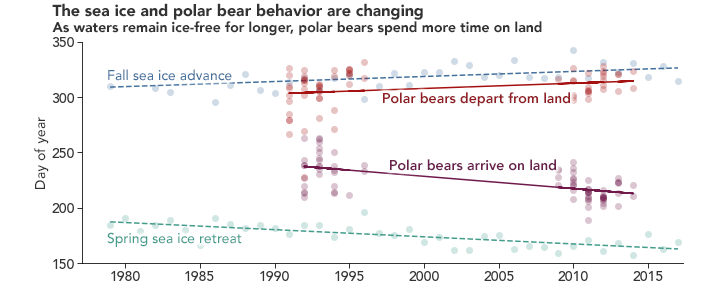

A polar bear’s life seems simple enough: eat seals, mate, and raise cubs. But a recent study shows some subpopulations of polar bears are struggling to complete these essential tasks because of declining concentrations of Arctic sea ice.
The Arctic sea ice cap is a large area of frozen seawater floating on top of the Arctic Ocean and its surrounding seas and straits. For polar bears, the sea ice is a crucial platform for life. They use the ice to travel long distances to new areas. They hunt for seals by finding their dens or sitting next to gaps in the ice, waiting for the unsuspecting prey to pop up. Sometimes, pregnant females dig in the sea ice to create maternity dens, where they give birth and take care of their cubs.
In recent decades though, this critical habitat has been shrinking. Sea ice concentrations have declined by 13 percent each decade since 1979 due to increasing global temperatures. Arctic regions have warmed twice as fast as the rest of the world, so seasonal sea ice is also forming later in the fall and breaking up earlier in the spring.
“We know that sea ice, which is where the bears need to be, is decreasing very rapidly,” said Kristin Laidre, an Arctic ecologist at the University of Washington. “When there’s no sea ice platform, the bears end up moving onto land with no or minimal access to food. Our research looked at how these changes affect their body condition and reproduction.”
In a new study published in Ecological Applications, Laidre and her colleagues described how declining sea ice concentrations are affecting the behavior, health, and reproductive success of polar bears. Using field observations and remote sensing, the study showed that polar bears are spending more time on land and are fasting for longer periods of time. Mother bears are also producing smaller cub litters, which the team projected will continue to decline for the next three polar bear generations.
“Climate-induced changes in the Arctic are affecting polar bears,” said Laidre, who was the main author of the study. “They are an icon of climate change, but they’re also an early indicator of climate change because they are so dependent on sea ice.”
The team specifically studied a subpopulation of bears that depend on seasonal sea ice in Baffin Bay. The team tracked polar bear movements across the bay over the past two decades. The map at the top of this page shows the movements of 43 tagged adult females from 1991-1997 (left) and 38 adult females from 2009-2015 (right).
They found that most bears follow the seasonal growth and recession of sea ice to end up on Baffin Island in the fall, when sea ice is usually at its lowest extent. They usually wait on Baffin Island until the ice forms again so they can leave. On average, the bears are spending 30 more days on land now than they did in the 1990s. Laidre says that is because the ice is retreating earlier and there has been more open water in recent summers.
The maps above show the difference in sea ice extent around Baffin Bay on July 15, 1993 and July 15, 2013. The satellite data are processed by NASA-funded scientists and stored at the National Snow and Ice Data Center. The graph below shows the onshore arrival and departure of polar bears on Baffin Island relative to dates of sea ice advance and retreat. Sea ice has been breaking up earlier in the spring over the years (green) and is forming later in the fall (blue).

“That’s important because when the bears are on land, they do not hunt seals,” said Laidre. “They have the ability to fast, but if they don’t eat for longer periods, they get thinner. This can affect their overall health and reproductive success.”
To assess polar bear health, the team quantified the condition of bears by assessing their level of fatness after sedating them or inspecting them visually from the air. Laidre and colleagues classified fatness on a scale of 1 to 5. Results showed the bears’ body condition was linked with sea ice availability in the current and previous year.
Cub litter size was also affected by the body condition of the mothers and by sea-ice availability. The researchers found larger litter sizes when the mothers were in a good body condition and when spring breakup occurred later in the year, meaning bears had more time on the sea ice in spring to find food.
Then finally, the team used mathematical models to forecast future reproductive success. The model took into account the relationship between sea-ice availability and the bears’ body fat and variable litter sizes. They projected that the normal cub litter size of two may decrease within the next three polar bear generations (37 years), mainly due to the projected decline of sea ice in the coming decades.
The results of the study were not necessarily surprising for Laidre, who has been studying the changes in the Arctic ecosystem for the past 20 years. She says it is well known that changes in the climate are having a negative effect on polar bears. Even if greenhouse gases were curbed immediately, sea ice would likely continue to decline for several decades because large-scale changes take a long time to propagate through Earth’s climate system.
In the meantime, Laidre hopes this study’s information will be used to further understand the impacts of sea ice loss on the species.
“Polar bears are a harbinger for the future,” said Laidre. “The changes we document here are going to affect everyone around the globe.”
NASA Earth Observatory images by Joshua Stevens, using data courtesy of Kristin Laidre and Harry Stern at the University of Washington, and sea ice data from the National Snow & Ice Data Center (NSIDC). Story by Kasha Patel.